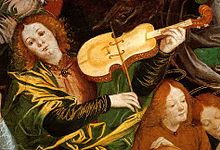
Back Viola da braccio Catalan Viola da braccio German Βιόλα ντα μπράτσο Greek Viola da braccio Spanish Viola da braccio Finnish Viola da braccio French Viola da braccio Hungarian ヴィオラ・ダ・ブラッチョ Japanese Viola da braccio Polish Viola da braccio Swedish

Viola da braccio (from Italian "arm viola", plural viole da braccio) is a term variously applied during the baroque period to instruments of the violin family, in distinction to the viola da gamba ("leg viola") and the viol family to which the latter belongs. At first "da braccio" seems to encompass the entire violin family. Monteverdi's Orfeo (printed 1609) designates an entire six-part string section "viole da brazzo", apparently including bass instruments held between the knees like the cello and bass violin. His Selva morale (1641) contains a piece calling for "due violini & 3 viole da brazzo ouero 3 Tronboni" (2 violins & 3 viole da braccio or trombones), reflecting a general shift in meaning towards the lower instruments. Eventually it came to be reserved for the alto member, the viola. A famous example is Bach's Sixth Brandenburg Concerto (1721), combining two viole da braccio with two viole da gamba. The German word for viola, Bratsche, is a relic of this last use.[1]
- ^ The Monteverdi examples are cited in Holman, Peter (2001). "Viola da braccio". In Sadie, Stanley; Tyrrell, John (eds.). The New Grove Dictionary of Music and Musicians (2nd ed.). London: Macmillan Publishers. ISBN 978-1-56159-239-5.
© MMXXIII Rich X Search. We shall prevail. All rights reserved. Rich X Search